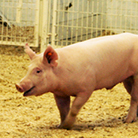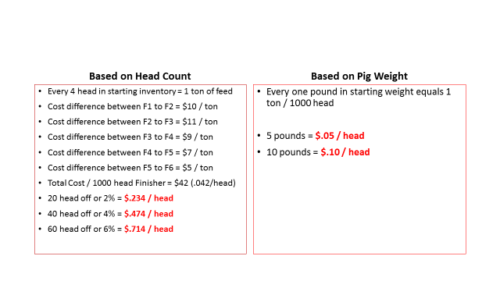Cost of Missing a Feed Budget in Finishing Pigs
Posted: May 16, 2016 | Written By: Tony Bohlke

Pork producers use feed budgets to more accurately feed a group of pigs. Feed budgets should be calculated by pounds per head for each ration whenever possible. Feeding based off of days does not account for intake fluctuations created on stocking density, health, and environment. The simplest information can be the most difficult to get accurate. Starting head count and starting weight is all that is needed to do an accurate feed budget. Missing or guessing on these two simple numbers could cost $.25 cents / head to over $1 per head. Based on 1,000 head started, the chart below shows the cost of overfeeding a budget based on head count and pig weight.

While underfeeding a budget will cost you in feed efficiency and other issues such as ear biting, tail biting, lameness and more cull pigs due to underfeeding amino acids, feed efficiency could be as much as 7% higher or .2 pounds more feed per pound of gain, resulting in a cost of three dollars per head. To get the most out of your feed budget, consider all of the following in calculating the feed budget.
- Communication – It is common practice for a producer to have the feed mill keep and maintain the only copy of the feed budget with estimated head count and weight. Only actual head counts and actual weights should be used. Unless you communicate with the feed mill, these numbers are only estimated, resulting in unnecessary expense.
- Budget by room or by building. Producers and feed mills like to budget by the site out of convenience. Head counts and weights should always be calculated on a per room basis as the youngest pigs or smaller pigs are generally put into one room or one building. If we budget a barn all as one and if one room is 10 pounds lighter, they will not receive enough of their 1st diet and this will continue to worsen as the feeding period goes on. It is also not uncommon to have a 20 to 50 head count difference between rooms or barns. In almost all situations convenience costs extra.
- Balance your budget. If you over or under feed a ration, you need to adjust the next rations to make up the deficiency or overfeeding.
Auditing your feed budgets is one of the easiest ways to protect your profits and optimize your return. Contact your Form-A-Feed representative to help you calculate your feed budget.